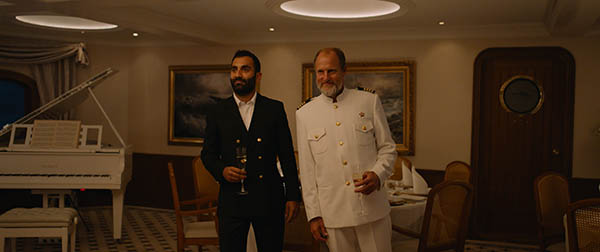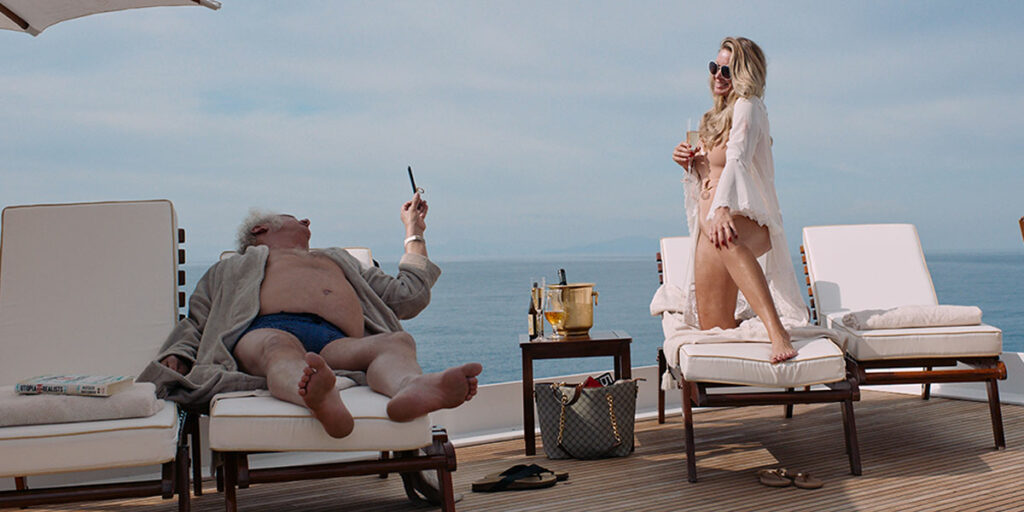As a satire on fashion and the super-rich, Ruben Östlund’s Triangle of Sadness has its moments, but isn’t entertaining or incisive enough to fully work.
I can’t get a hang of Ruben Östlund, the Swedish director who returns to Cannes this year after winning the Palme d’Or in 2017. On one hand, I liked Force Majeure, his 2014 black comedy about a father’s inadequacies and the dysfunctions of a family during a ski trip. On the other hand, The Square was extremely messy, an art world satire that loses focus on its story and the themes it is supposed to be examining. Now, after five years, Östlund is back with Triangle of Sadness. And after films at a ski resort and an art gallery, he’s set his newest film on a massive yacht – partly.
There are three distinct parts of Triangle of Sadness, named after a saggy section of the face around the eyebrows. This has apparently inflicted past-his-prime male model Carl (Harris Dickinson). It doesn’t help that his girlfriend Yaya (Charlbi Dean) is more successful yet still won’t pick up the restaurant bill, which leads to an almighty argument. Still, that doesn’t stop the couple from going on a yacht cruise for the uber-rich. To get a sense of how rich, their passengers include a Russian manure oligarch (Zlatko Burić) and a sweet old English couple (Oliver Ford Davies and Amanda Walker) who made their money selling hand grenades.
For Carl and Yaya, the cruise is free in exchange for some social media posts (taken by Carl of course, since he’s not the model that people want to see). But their trip turns into a disaster after a storm, some bad seafood during the Captain’s dinner and one of the old couple’s grenades. Eventually, a handful of the yacht’s passengers find themselves on a desert island, unable to fish or make a fire. The one who can do these things is cleaning lady Abigail (Dolly De Leon), who uses this to turn social hierarchies upside down. And maybe Carl can now use his good looks to his advantage.

Despite early indications, Triangle of Sadness is not really a fashion world satire. Instead, Östlund’s focus is more theological, interrogating extreme wealth and leaning towards Communism, Marxism and equal sharing (apart from in the third act). The film is simultaneously a relationship drama, a sweeping satire of the affluent 1% and a desert island movie. However, whilst some of these parts and moments are interesting, Triangle of Sadness has a big problem with its satire. The target is obvious: the super-rich who value luxury items but struggle with basic tasks. But the film isn’t incisive or entertaining enough to work.
The section that gets closest to pulling off Östlund’s intentions is on the yacht, where a clear social hierarchy is established before the ship devolves into chaos. Everything that happens to the rich passengers is a mess of their own making, a combination of privilege and guilt. The result is overflowing with sewage and snappy dialogue. Renoir’s Rules of the Game but with more bodily fluids, as shown in a scene that will make you either love or hate the film. Furthermore, this section features an entertaining turn from Woody Harrelson, playing a drunk Marxist captain who gets into a quote-off with a capitalist Russian (the irony).
Unfortunately, when we wash up on the island, the rest of the film becomes quite insufferable. Östlund’s penchant for long, overdrawn scenes comes to the fore here as he reinforces the theme of corrupting power, something seen time and again and something that the director doesn’t do anything particularly new with. It doesn’t help that Dolly De Leon’s cleaner is not given enough characterisation beforehand. Really, this is a problem with the whole film. The best parts of Force Majeure are rooted in the characterisation – the father’s male insecurities are important but are also shown through the effect they have on his family and the troubles they all have. In comparison, Triangle of Sadness’ characters are just rich caricatures whose Östlund subjects to misery, so our collective reaction turns from schadenfreude to sympathy. Except that mostly doesn’t work.
Triangle of Sadness is slightly more enjoyable than The Square but is still a flawed satire from director Ruben Östlund. He and cinematographer Fredrik Wenzel make the film look nice, and Harrelson and a wide-eyed Dickinson give their all. But the moments of humour mostly fall flat, scenes are drawn out for a little bit too long, and an anti-climactic ending comes right as we get to an interesting crossroads in the story. It all leads to you wondering what the film really wanted to say. Once again, the points about the rich are here – but they aren’t cutting edge.
Triangle of Sadness premiered at the 2022 Cannes Film Festival on May 21, 2022 and is now available on digital and on demand. Read our interview with star Dolly De Leon below and check out our reviews of the Dolly De Leon-starring Between The Temples, Ghostlight, Jackpot!, and Family Therapy!

